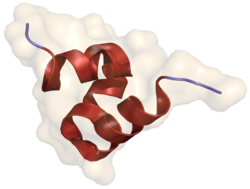Function
Osteocalcin is secreted solely by osteoblasts and is thought to play a role in the body's metabolic regulation. [12] In its carboxylated form, calcium is bound directly to the bone and thus concentrates here.
In its uncarboxylated form, osteocalcin acts as a hormone in the body, signalling in the pancreas, fat, muscle, testes, and brain. [13]
- In the pancreas, osteocalcin acts on beta cells, causing beta cells in the pancreas to release more insulin. [12]
- In fat cells, osteocalcin triggers the release of the adiponectin hormone, which increases insulin sensitivity. [12]
- In muscle, osteocalcin acts on myocytes to promote energy availability and utilization and, in this manner, favors exercise capacity. [14] [15]
- In the testes, osteocalcin acts on Leydig cells, stimulating testosterone biosynthesis and affecting male fertility. [16]
- In the brain, osteocalcin plays an important role in development and functioning, including spatial learning and memory. [17]
An acute stress response (ASR), colloquially known as the fight-or-flight response, stimulates osteocalcin release from bone within minutes in mice, rats, and humans. Injections of high levels of osteocalcin alone can trigger an ASR in the presence of adrenal insufficiency. [18] [19] [20]
This page is based on this
Wikipedia article Text is available under the
CC BY-SA 4.0 license; additional terms may apply.
Images, videos and audio are available under their respective licenses.






